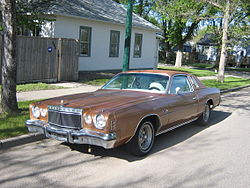Chrysler Cordoba
| Chrysler Cordoba | |
|---|---|
| Production period: | 1974-1983 |
| Class : | upper middle class |
| Body versions : | Coupe |
The Chrysler Cordoba was an upper middle class coupé produced in two generations from 1975 to 1983 by the US automobile manufacturer Chrysler . The Cordoba was the first Chrysler car that was not a full-size model. The Dodge Division , which belongs to the Chrysler Group , offered slightly modified versions of the Cordoba under the names Charger SE (1975–1979) and Mirada (1980–1983).
Cordoba (B-Body)
| 1st generation | |
|---|---|
|
Chrysler Cordoba (1976) |
|
| Production period: | 1975-1979 |
| Body versions : | Coupe |
| Engines: |
Petrol engines : 5.2–6.6 liters (101–179 kW) |
| Length: | 5469 mm |
| Width: | 1958 mm |
| Height: | 1336 mm |
| Wheelbase : | 2920 mm |
| Empty weight : | 1793-1822 kg |
The Cordoba was Chrysler's first model in the personal luxury car class . The car was aimed at competitors like the Chevrolet Monte Carlo and the Ford Elite , which were produced annually in mostly six-digit numbers since 1969 and 1974 respectively.
The first generation of the Chrysler Cordoba was based on the Group's own B platform . It was closely related to the mid-range models Dodge Coronet (called Dodge Monaco from 1977 ) and the Plymouth Satellite (later: Plymouth Fury ). The design of the Cordoba, however, was independent. It was perceived in the American press as "a very good cross between a Chevrolet Monte Carlo and a Jaguar XJ6". In particular, the round light units on the front of the first version (1974 to 1977) created associations with the Jaguar. For the 1978 model year, the Cordoba underwent a facelift and received the rectangular twin headlights that were widely used at the time and were arranged one above the other. This made it look very similar to the 1976/77 Chevrolet Monte Carlo from the front.
The Cordoba was powered exclusively by large-volume V8 engines with displacements from 5.2 to 6.6 liters. Starting in 1977, all engines were equipped with Chrysler's Lean Burn System to reduce fuel consumption . Chrysler's TorqueFlite three-speed automatic transmission served as power transmission.
The Cordoba was one of the few sales successes that Chrysler could show in the late 1970s. In the early years, the Cordoba accounted for more than half of all Chrysler model production. Chrysler produced a total of almost 700,000 copies of the first-generation Cordoba.
A special version of the Cordoba was the Chrysler 300 , which was only offered in 1979, the last model year of the first generation. It was a sporty version of Cordoba.
The Dodge Division , which is part of the Chrysler Group , offered a hardly changed version of the car under the name Dodge Charger from 1975 to 1978 , which was less successful than the Cordoba.
Cordoba (J-Body)
| 2nd generation | |
|---|---|
|
Chrysler Cordoba (1980) |
|
| Production period: | 1979-1983 |
| Body versions : | Coupe |
| Engines: |
Petrol engines : 3.7-5.9 liters (63-138 kW) |
| Length: | 5329 mm |
| Width: | 1847 mm |
| Height: | 1354 mm |
| Wheelbase : | 2865 mm |
| Empty weight : | 1481-1595 kg |
The new Cordoba, released in autumn 1979, was based on the platform of the Chrysler LeBaron and was 15 cm shorter and over 300 kg lighter than its predecessor. Standard now was the Chrysler inline six-cylinder, known as the Slant Six , which was extremely reliable, but clearly too weak for the big coupés. The well-known 5.2-liter V8 and (only for model year 1980) the 5.9-liter V8 were available for an extra charge.
The Cordoba was offered in the model years 1980 to 1983 as a basic model, from 1980 to 1982 also as a sportier, more spartan LS model and only in 1980 in the luxury version Cordoba Crown , which was also available as a Corinthian Edition with a special paintwork and a particularly lavish interior.
The design of the second Cordoba generation found fewer friends, however, and the second oil crisis in 1979 had a detrimental effect on the entire vehicle category, and sales figures fell. While sales of the competing models recovered, sales of the Cordoba remained at a low level. After Chrysler began to focus on new, smaller front-wheel drive models, the production of the Cordoba was discontinued in 1983 without replacement.
Chrysler sold a total of 95,000 units of the second generation Cordoba.
swell
Flammang, James M./Kowalke, Ron: Standard Catalog of American Cars 1976-1999. Krause Publishing, Iola 1999. ISBN 0-87341-755-0
Footnotes
- ↑ Langworth: Encyclopedia of American Cars 1930-1980, pp. 195 f.

